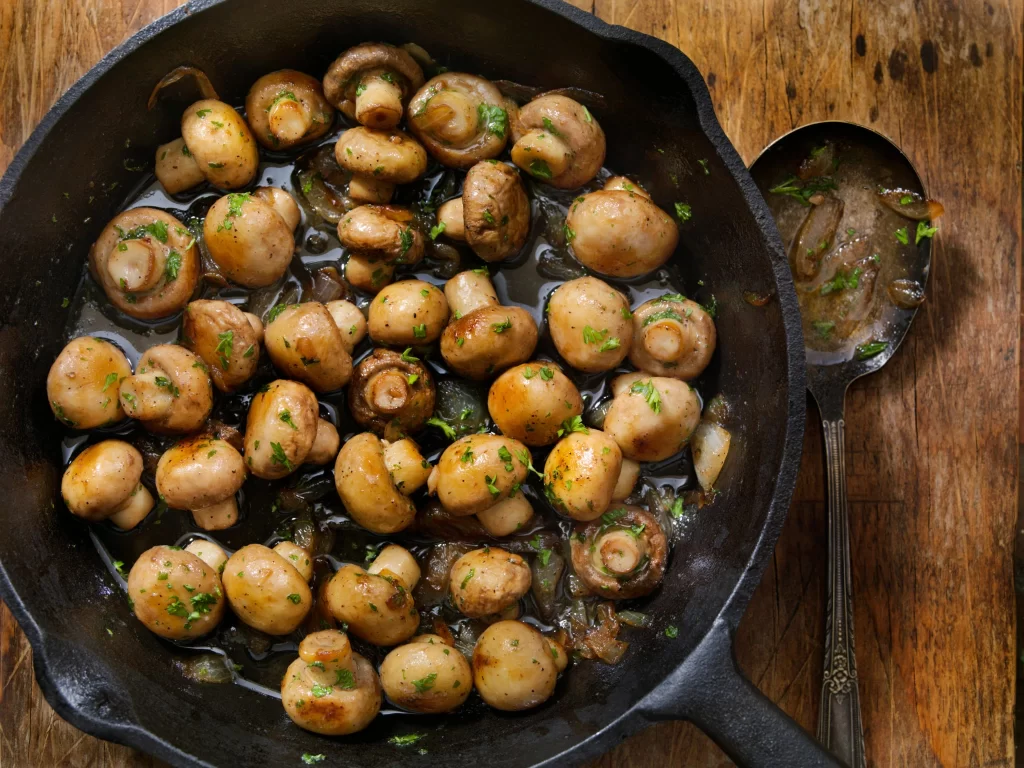Mushrooms have a lot of ingrained nutrients that make them all the more appealing to eat, aside from their taste. Whether mushrooms are eaten raw or cooked, they offer several nutritional values to humans. So what is the nutritional value of raw and cooked mushrooms?

Raw Mushrooms and Cooked Mushrooms
Raw mushrooms are low in calories but high in fibre and protein, as well as having B vitamins, potassium, and selenium. Mushrooms also contain iron, zinc, copper, magnesium, and beta-glucans, which boost the immune system, among others.
However, when mushrooms are cooked, there is a slight change in nutritional content; cooked mushrooms have a reduced amount of vitamin C but increased vitamin B.
Whatever the change in nutritional content, cooking mushrooms have no disappearing effect on the nutrients, so both raw and cooked mushrooms are beneficial.
READ ALSO:
- Whole Foods Delivery: What You Should Know
- What is Oyster Sauce Made Of?
- What Time Does Burger King Stop Serving Breakfast?
Are Mushrooms More Beneficial Cooked Or Raw?
Although raw mushrooms contain nutrients, they also have some toxic components, like carcinogens, which are cancer-causing agents. This is just one among many others. But don’t fret; cooking mushrooms is the answer to getting rid of these toxins!
Not all cooking methods are advised when cooking mushrooms, though, especially boiling, as it only enhances nutrient loss. Frying, on the other hand, helps retain mushroom nutrients.
Simply put, mushrooms are more beneficial when cooked; cooking reduces toxins in mushrooms, boosts nutrition, and enhances taste.
Can You Cook The Nutrients Out Of Mushrooms?
Some nutrients can be lost when cooking mushrooms, but despite possible nutrient loss, it is unhealthy to consume raw mushrooms.
The extent of nutrient loss in mushrooms only depends on the cooking method adopted for them. For instance, as stated earlier, boiling causes the most loss of nutrients in mushrooms. The best methods you can use that help you still retain nutrients are grilling and microwaving.
Again, although cooking mushrooms decreases some nutrients, it enhances some others, like beta-glucans and other antioxidants, making them more readily bioavailable. But all in all, you are sure to get nutrients from cooked mushrooms. These are facts backed up by lots of research.
Are There Any Benefits To Eating Raw Mushrooms?
Quite frankly, eating raw mushrooms presents some benefits that may not be gotten from cooked mushrooms. Raw mushrooms contain more enzymes, which aid in digestion. Raw mushrooms also contain antioxidants.
Additionally, raw mushrooms help with weight loss; mushrooms are now a vital part of any good weight loss diet because they are a low-calorie, high-fibre food. Raw mushrooms have approximately 20 calories and 3 grams of fibre per 100 grammes.
Again, mushrooms support gut health as they contain prebiotics, which are fibre types that help nourish the good bacteria in your gut. This bacteria helps with digestion, immunity, and overall health. These and many others are the benefits of eating raw mushrooms, despite their carcinogens.
It is also possible to get these benefits from cooked mushrooms, but the fact remains that they are more pronounced in raw form, as they are still in fresh form and have not yet been introduced to heat.
Do Fresh Mushrooms Have Any Nutritional Value?
Absolutely! Fresh mushrooms contain B vitamins like folate, niacin, and riboflavin, which are vital for energy production and red blood cell formation. Ergosterols, which have anti-cancer properties, are also embedded in fresh mushrooms. Mushrooms also contain chitin, which lowers cholesterol levels.
What’s more, mushrooms possess beta-glucans, which are useful for boosting the immune system by increasing white blood cells. Beta-glucans have anti-tumor properties. Mushrooms also reduce inflammation and improve heart health.
What seems to be the icing on the cake, however, is the fact that mushrooms are a great source of water, which, of course, keeps the body hydrated and functioning.
READ ALSO:
- What Is Chamoy And How Is It Made?
- What is in Banana Pudding Moonshine?
- Does Vegan Cheese Taste Nice? Puzzle Solved
How Many Calories Are in Cooked Mushrooms?
Different mushroom types have different calorie counts. On average, a cup of cooked mushrooms has about 40–60 calories. Shiitake mushrooms rank at 20 calories per cup when cooked, while portobello has 40 calories.
The lowest are the white-button mushrooms, which have just 15 calories per cup when cooked. This mushroom type is the best option for those who want to keep their calorie count low.
It cannot be ignored that the calorie count in mushrooms also depends on the oils, butter, and seasonings that are added during cooking. But at the end of the day, mushrooms remain a great low-calorie food option.
Conclusion
To fully enjoy mushrooms and all they have to offer, whether fresh or cooked, they need to be properly stored to preserve their nutritional value. So keep those mushrooms in paper bags or breathable containers, place them in the fridge, and try to use them within a week or two of their purchase.
In conclusion, mushrooms are a nutritious and delicious food, whether eaten raw or cooked. They are low in calories, high in fibre, and packed with vitamins and minerals.
Their versatility makes them a great addition to any meal, whether you’re looking for a hearty dinner or a light snack. And best of all, they can be enjoyed by people of all age brackets and dietary needs. So, be sure to add mushrooms to your next meal—your body will thank you for it!

